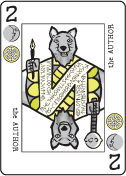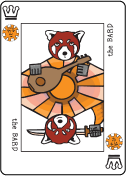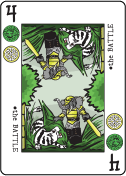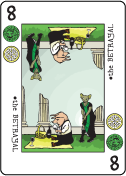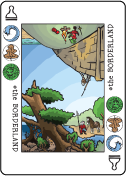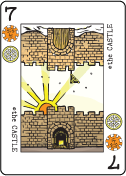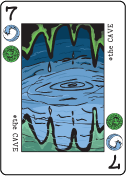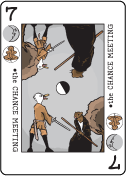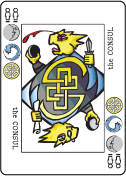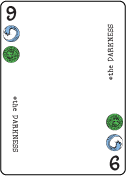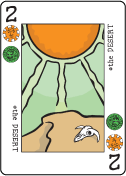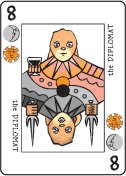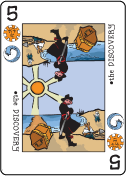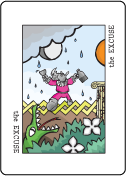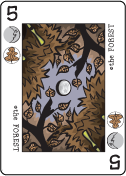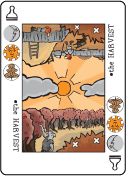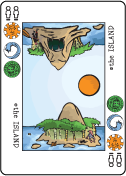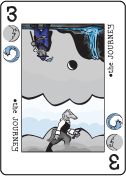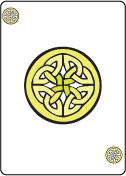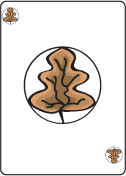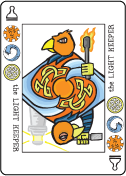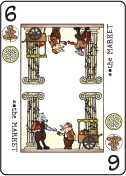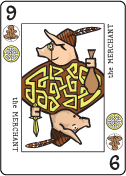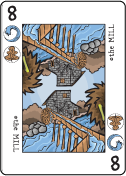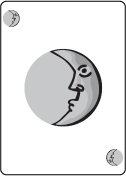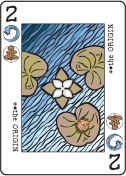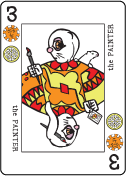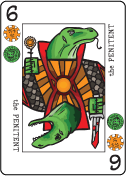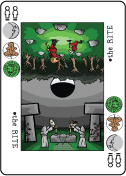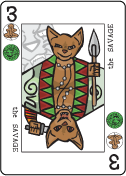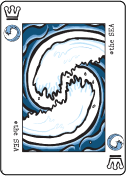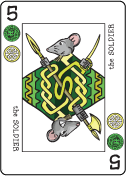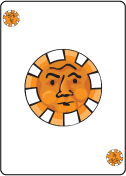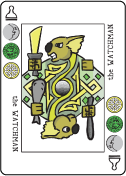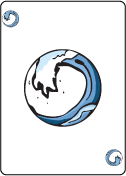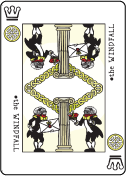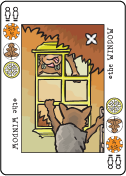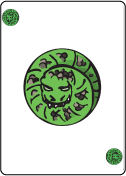Pandemonium deck: Difference between revisions
imported>Wordman (Completed influence effects) |
imported>Wordman mNo edit summary |
||
| Line 1: | Line 1: | ||
''This is a magic item for [[system::Pathfinder]] based on P.D. Magnus' [http://www.decktet.com/ Decktet]. Though inspired by the ''[[pfsrd:magic-items/artifacts/minor-artifacts/deck-of-many-things-harrow|harrow deck of many things]]'' (in turn inspired by the ''[[pfsrd:magic-items/artifacts/minor-artifacts/deck-of-many-things|deck of many things]]''), it alters the whole concept of the deck (roughly) following the model used by ''[http://www.amazon.com/gp/product/0786958723/ref=as_li_ss_tl?ie=UTF8&camp=1789&creative=390957&creativeASIN=0786958723&linkCode=as2&tag=div05a-20 Madness at Gardmore Abbey]'' to make the deck a less destabilizing force, at least at first.'' | ''This is a magic item for [[system::Pathfinder]] based on P.D. Magnus' [http://www.decktet.com/ Decktet]. Though inspired by the ''[[pfsrd:magic-items/artifacts/minor-artifacts/deck-of-many-things-harrow|harrow deck of many things]]'' (in turn inspired by the ''[[pfsrd:magic-items/artifacts/minor-artifacts/deck-of-many-things|deck of many things]]''), it alters the whole concept of the deck (roughly) following the model used by ''[http://www.amazon.com/gp/product/0786958723/ref=as_li_ss_tl?ie=UTF8&camp=1789&creative=390957&creativeASIN=0786958723&linkCode=as2&tag=div05a-20 Madness at Gardmore Abbey]'' to make the deck a less destabilizing force, at least at first.'' | ||
'''Aura''' strong (all schools); '''CL''' 20th; '''Slot''' none; '''Weight''' — | '''Aura''' strong (all schools; chaotic); '''CL''' 20th; '''Slot''' none; '''Weight''' — | ||
This worn fortune-teller's (and gambler's) deck bears an evocative image upon each of its forty-five cards. The deck contains six suits (in order: moons, suns, waves, leaves, wyrms and knots) with a complex structure. For each suit, there is an Ace and a Crown. Ranked between them are other cards numbered 2 through 9, each with two suits. Four Courts each have three suits and are ranked beneath Crowns. Four Pawns each have three suits as well, ranked below Courts. The Excuse has no suit or rank. Suit combinations do not occur with equal frequency. All cards also have a theme or meaning, written on the face of the card (one third represent people, one third represent places and one third represent events). Some cards appear the same when upside down, some do not. | This worn fortune-teller's (and gambler's) deck bears an evocative image upon each of its forty-five cards. The deck contains six suits (in order: moons, suns, waves, leaves, wyrms and knots) with a [http://wiki.decktet.com/structure complex structure]. For each suit, there is an Ace and a Crown. Ranked between them are other cards numbered 2 through 9, each with two suits. Four Courts each have three suits and are ranked beneath Crowns. Four Pawns each have three suits as well, ranked below Courts. The Excuse has no suit or rank. Suit combinations do not occur with equal frequency. All cards also have a theme or meaning, written on the face of the card (one third represent people, one third represent places and one third represent events). Some cards appear the same when upside down, some do not. | ||
== Individual Cards == | == Individual Cards == | ||
Cards of this deck are almost never found assembled, as the deck has the ability to scatter itself under certain circumstances. Most who come across cards find them singly. Individual cards are no more or less durable than mundane cards; however, should a card be | Cards of this deck are almost never found assembled, as the deck has the ability to scatter itself under certain circumstances. Most who come across cards find them singly. Individual cards are no more or less durable than mundane cards; however, should a card be seriously damaged, it turns to dust and reforms itself whole at some other random location in the world. | ||
Individual cards make their presence known | Individual cards make their presence known when combat begins. Whenever an initiative check is made, the GM randomly selects one of the cards possessed by the participants in the combat. This card then exerts an influence on the battle. A spectral icon representing the card appears on the ground in a random square adjacent to the character who owns the selected card. Anyone standing in the square containing the icon gains the influence effect listed for that card, so long as they remain in the same square as the icon. If the character moves out of the square (or the icon moves out from under the character) the influence effect ends immediately. | ||
Any spell-like abilities granted by cards function with a caster level equal to your level. When an influence that grants a spell-like ability leaves a character, the character can no longer use the spell-like ability, but any instances of the spell cast while the character was under the influence remain running as per their normal duration. (In contrast, characters under an influence that gives them an ability "as if" under the effects of a spell lose that ability immediately when the influence leaves them.) | Any spell-like abilities granted by cards function with a caster level equal to your level. When an influence that grants a spell-like ability leaves a character, the character can no longer use the spell-like ability, but any instances of the spell cast while the character was under the influence remain running as per their normal duration. (In contrast, characters under an influence that gives them an ability "as if" under the effects of a spell lose that ability immediately when the influence leaves them.) | ||
At the start of each round, the icon moves 1d4-1 squares in a random direction (roll 1d8, with 1 indicating north and the other numbers indicating compass going clockwise). If the icon would move into an obstacle (e.g. wall, the edge of a cliff, etc.), it instead just stops. Any creatures standing final destination of the icon immediately gain the influence effect of the card. | At the start of each round, the icon moves 1d4-1 squares in a random direction (roll 1d8, with 1 indicating north and the other numbers indicating compass going clockwise). If the icon would move into an obstacle (e.g. wall, the edge of a cliff, etc.), it instead just stops. Any creatures standing in final destination of the icon immediately gain the influence effect of the card. | ||
Characters who own cards may spend a standard action attempting to force a card they own to become the influencing card. Success on a Use Magic Item check (DC 18) causes any existing influence to vanish, and a new influence icon to appear at a random square adjacent to the card owner. Any character in that square immediately gains the influence effect of the new card. | Characters who own cards may spend a standard action attempting to force a card they own to become the influencing card. Success on a Use Magic Item check (DC 18) causes any existing influence to vanish, and a new influence icon to appear at a random square adjacent to the card owner. Any character in that square immediately gains the influence effect of the new card. | ||
| Line 56: | Line 56: | ||
|- | |- | ||
| three wyrms + three knots | | three wyrms + three knots | ||
| You may ''[[pfsrd:feats/metamagic-feats/quicken-spell-metamagic---final quickened]'' ''[[pfsrd-spell:d/detect-chaos|detect chaos]]'' at will as a spell-like ability. | | You may ''[[pfsrd:feats/metamagic-feats/quicken-spell-metamagic---final quickened]]'' ''[[pfsrd-spell:d/detect-chaos|detect chaos]]'' at will as a spell-like ability. | ||
|- | |- | ||
| three moons + three wyrms | | three moons + three wyrms | ||
| Line 80: | Line 80: | ||
|- | |- | ||
| one card of each rank + the excuse | | one card of each rank + the excuse | ||
| Once per day, you may broadcast a ''[[pfsrd-spell:s/sending|sending]]'' which is heard by any creature who owns six or more cards. | | Once per day, you may broadcast a ''[[pfsrd-spell:s/sending|sending]]'' which is heard by any creature who owns six or more cards. Any responses are also heard by all who heard the original sending. | ||
|- | |- | ||
| moons of each rank | | moons of each rank | ||
| Line 105: | Line 105: | ||
Should one character assemble the complete deck, the true power of the deck reveals itself. The owner of the deck may perform an hour long ritual culminating in the owner (or someone she designates) drawing one or more cards from the deck. If the one drawing is lawful, they may draw only one card. If the one drawing is chaotic, they may draw up to three cards. Otherwise the one drawing may draw up to two cards. Regardless of who draws, the owner of the deck chooses one of the drawn cards, and the major effect listed for that card activates (targeting the one who drew it). Major effects are permanent and cannot be eliminated without powerful magic, such as a ''wish'' or ''miracle''. | Should one character assemble the complete deck, the true power of the deck reveals itself. The owner of the deck may perform an hour long ritual culminating in the owner (or someone she designates) drawing one or more cards from the deck. If the one drawing is lawful, they may draw only one card. If the one drawing is chaotic, they may draw up to three cards. Otherwise the one drawing may draw up to two cards. Regardless of who draws, the owner of the deck chooses one of the drawn cards, and the major effect listed for that card activates (targeting the one who drew it). Major effects are permanent and cannot be eliminated without powerful magic, such as a ''wish'' or ''miracle''. | ||
Afterwards, each card drawn disintegrates and reforms at a random location (as mentioned above). The owner of the deck immediately becomes aware of the location of the card that was activated (but not the other | Afterwards, each card drawn disintegrates and reforms at a random location (as mentioned above). The owner of the deck immediately becomes aware of the location of the card that was activated (but not the other cards drawn, if any). No longer in possession of a complete deck, the owner must track down the lost cards in order to complete the deck and draw again. Note that, since the new cards are not technically the same object as the cards that were drawn, the deck's owner has never handled the new cards, which prevents divination spells that require such handling from locating the new cards. | ||
Some major effects also cause additional cards from the deck to vanish and reappear elsewhere. This may happen in one of two ways. If the deck '''divides''', undrawn cards are distributed at random into four separate piles, as evenly as possible. One pile, chosen at random, remains where it is. The other piles teleport to random locations within 100 miles. If the deck '''scatters''', all undrawn cards teleport to random locations within 2,000 miles. | Some major effects also cause additional cards from the deck to vanish and reappear elsewhere. This may happen in one of two ways. If the deck '''divides''', undrawn cards are distributed at random into four separate piles, as evenly as possible. One pile, chosen at random, remains where it is. The other piles teleport to random locations within 100 miles. If the deck '''scatters''', all undrawn cards teleport to random locations within 2,000 miles. | ||
| Line 115: | Line 115: | ||
When adjudicating matters related to the ''deck'', keep the desires of this consciousness in mind. Take the Windfall card, for example, which makes a character an heir to a noble title. While this might result in a character taking up the reins of power peacefully, the ''deck'' would much prefer that a full on civil war broke out instead. Along the same lines, the ''deck'' wants people to fight over its cards when trying to unify the deck. | When adjudicating matters related to the ''deck'', keep the desires of this consciousness in mind. Take the Windfall card, for example, which makes a character an heir to a noble title. While this might result in a character taking up the reins of power peacefully, the ''deck'' would much prefer that a full on civil war broke out instead. Along the same lines, the ''deck'' wants people to fight over its cards when trying to unify the deck. | ||
== Notoriety == | == The Notoriety == | ||
The ''deck'' uses a subtle ability (called the Notoriety) to spread information to further its own ends. This ability is under the control of the GM and works in four ways: | The ''deck'' uses a subtle ability (called the Notoriety) to spread information to further its own ends. This ability is under the control of the GM and works in four ways: | ||
| Line 136: | Line 136: | ||
'''Influence Effect''' You can read, speak and understand any language, as if under the influence of a ''[[pfsrd-spell:t/tongues|tongues]]'' spell. You also may cast ''[[pfsrd-spell:c/command|command]]'' at will as a spell-like ability. | '''Influence Effect''' You can read, speak and understand any language, as if under the influence of a ''[[pfsrd-spell:t/tongues|tongues]]'' spell. You also may cast ''[[pfsrd-spell:c/command|command]]'' at will as a spell-like ability. | ||
'''Major Effect''' | '''Major Effect''' On the first new moon of each season, you may make a ''[[pfsrd-spell:w/wish|wish]]'' on behalf of someone you hadn't met before drawing the card or since you made your last ''wish''. The person for whom you are wishing must have articulated a desire for the wish to you in some way. | ||
'''Notoriety''' | '''Notoriety''' Rumors spread that the character who drew the card grants wishes, but most of them are coupled with untruthful riders about what the character wants (or must have) in order to grant one. For example, a story starts to circulate in the village the character just entered that the first person who presents her with a cup filled with the blood of a sacrificed virgin will be granted a wish. Or that wishes are only granted to those who truly hate the character's race. Or that whoever sleeps with the character under a full moon automatically gets their wish. | ||
</div> | </div> | ||
| Line 149: | Line 149: | ||
'''Influence Effect''' You gain a +4 luck bonus to charisma. | '''Influence Effect''' You gain a +4 luck bonus to charisma. | ||
'''Major Effect''' You | '''Major Effect''' You gain an alter ego as a notorious bard. Create a character with different gender and race than your main character, but with the same number of character levels. All of this character's levels are bard levels and you (with input from the GM) may outfit the bard with 40,000gp worth of equipment. Three times per day, you may spend one minute transforming from your main character to the bard, or vice-versa. The two characters are aware of each other, but maintain separate personalities, motivations and memories. Personal possessions are tracked separately, and disappear when the other character takes over. Experience gained by either character is applied to both. If you are already a bard, this new bard is a rival and you cannot stand each other. | ||
'''Notoriety''' | If the new moon rises and you have not switched since the rise of the last new moon, you automatically transform into your other self, and may not switch back until the next new moon. | ||
'''Notoriety''' Whenever the character who drew the card arrives in a new town or other major area (either as herself or the bard), the Notoriety plants memories in key residents of the location of some past trouble or scandal the bard caused. Perhaps the bard seduced a local noble, or performed a song that insulted the local religion or stole from the local blacksmith guild. | |||
</div> | </div> | ||
| Line 157: | Line 159: | ||
<div style="overflow: hidden"> | <div style="overflow: hidden"> | ||
[[Image:Decktet-battle.png|right| | [[Image:Decktet-battle.png|right|Battle]] | ||
'''Rank/Suits''' Four (wyrms, knots) | '''Rank/Suits''' Four (wyrms, knots) | ||
'''Influence Effect''' You may [[pfsrd:feats/combat-feats/cleave-combat|cleave]] as if you had the feat. If you already have cleave, you may [[pfsrd:feats/combat-feats/great-cleave-combat---final|great cleave]] as if you had the feat. If you have that feat as well, you no longer take the -2 AC penalty when you use it. | '''Influence Effect''' You may [[pfsrd:feats/combat-feats/cleave-combat|cleave]] as if you had the feat. If you already have cleave, you may [[pfsrd:feats/combat-feats/great-cleave-combat---final|great cleave]] as if you had the feat. If you have that feat as well, you no longer take the -2 AC penalty when you use it. | ||
'''Major Effect''' The deck divides. | '''Major Effect''' The deck divides. Whenever you, or a faction to which you have sworn allegiance, is involved in open conflict involving more than 100 people, your side always loses (though you may survive). A "faction" refers to some group, organization, army, nation or other body that might enter into conflict with similar factions. If you somehow manage to swear allegiance to more than one conflicting faction, all of them loose (either through mutual destruction or by one gaining a victory that costs it more than it gains). Any time you swear allegiance to a faction, the ''deck'' places a ''[[pfsrd-spell:g/geas|geas]]'' on you (as a level 20 caster) to honor your pledge until you are released from it. When your faction loses a battle, they may release you from your pledge, but are under no obligation to do so. | ||
'''Notoriety''' | '''Notoriety''' A prophesy surfaces that any military force which claims the allegiance of the "chosen one" (who bears an uncanny resemblance to the character who drew the card) cannot be defeated. Those who learn of this prophesy may make tempting offers or apply terrible leverage to gain the character's allegiance. | ||
</div> | </div> | ||
| Line 173: | Line 175: | ||
'''Rank/Suits''' Eight (wyrms, knots) | '''Rank/Suits''' Eight (wyrms, knots) | ||
'''Influence Effect''' You may cast ''[[pfsrd-spell:c/confess|confess]]'' at will as a spell-like ability. If cast on an ally, add 4 to the save DC. | '''Influence Effect''' You may cast ''[[pfsrd-spell:c/confess|confess]]'' at will as a spell-like ability. If cast on an ally, add +4 to the save DC. | ||
'''Major Effect''' | '''Major Effect''' If you die, all allied player characters in your party gain 10,000xp each. If the lethal blow was dealt by an ally (not necessarily the other PCs), this award increases to enough experience to advance each PC in your party to the next level, or 25,000xp, whichever is higher. Should you be raised or otherwise brought back from the dead, this xp is lost. If you own the ''deck'' when you die, it divides, but each of the piles winds up in the hands of an ally (the largest is given to the ally who delivered the killing strike, if any). | ||
'''Notoriety''' | '''Notoriety''' If the character who drew the card does anything counter to the interests of the other PCs, the Notoriety sees to it that they find out about it. Also, animal companions, familiars and the like of ''all'' the PCs become convinced that if they arrange the death of their master, they will be set free. | ||
</div> | </div> | ||
| Line 294: | Line 296: | ||
'''Major Effect''' The deck scatters. You gain the one-time ability to issue a single command to any creature in the multiverse and have the order obeyed. The target is affected as if by the spell ''[[pfsrd-spell:d/dominate-monster|dominate monster]]'', and even orders for the target to kill itself are followed. Any creature targeted by this effect knows that it is acting against its will, and knows the identity and location of you. Immortal creatures cannot effectively kill themselves, and the act only causes them considerable but fleeting pain. Additionally, creatures with the ability to grant such boons typically also possess the power to revoke them, and do so as soon as the command releases them. The GM ultimately decides what this command can accomplish. You may use this card's effect whenever you wish, but may only use it once. | '''Major Effect''' The deck scatters. You gain the one-time ability to issue a single command to any creature in the multiverse and have the order obeyed. The target is affected as if by the spell ''[[pfsrd-spell:d/dominate-monster|dominate monster]]'', and even orders for the target to kill itself are followed. Any creature targeted by this effect knows that it is acting against its will, and knows the identity and location of you. Immortal creatures cannot effectively kill themselves, and the act only causes them considerable but fleeting pain. Additionally, creatures with the ability to grant such boons typically also possess the power to revoke them, and do so as soon as the command releases them. The GM ultimately decides what this command can accomplish. You may use this card's effect whenever you wish, but may only use it once. | ||
'''Notoriety''' | '''Notoriety''' Whenever | ||
</div> | </div> | ||
Revision as of 22:45, 13 February 2013
This is a magic item for Pathfinder based on P.D. Magnus' Decktet. Though inspired by the harrow deck of many things (in turn inspired by the deck of many things), it alters the whole concept of the deck (roughly) following the model used by Madness at Gardmore Abbey to make the deck a less destabilizing force, at least at first.
Aura strong (all schools; chaotic); CL 20th; Slot none; Weight —
This worn fortune-teller's (and gambler's) deck bears an evocative image upon each of its forty-five cards. The deck contains six suits (in order: moons, suns, waves, leaves, wyrms and knots) with a complex structure. For each suit, there is an Ace and a Crown. Ranked between them are other cards numbered 2 through 9, each with two suits. Four Courts each have three suits and are ranked beneath Crowns. Four Pawns each have three suits as well, ranked below Courts. The Excuse has no suit or rank. Suit combinations do not occur with equal frequency. All cards also have a theme or meaning, written on the face of the card (one third represent people, one third represent places and one third represent events). Some cards appear the same when upside down, some do not.
Individual Cards
Cards of this deck are almost never found assembled, as the deck has the ability to scatter itself under certain circumstances. Most who come across cards find them singly. Individual cards are no more or less durable than mundane cards; however, should a card be seriously damaged, it turns to dust and reforms itself whole at some other random location in the world.
Individual cards make their presence known when combat begins. Whenever an initiative check is made, the GM randomly selects one of the cards possessed by the participants in the combat. This card then exerts an influence on the battle. A spectral icon representing the card appears on the ground in a random square adjacent to the character who owns the selected card. Anyone standing in the square containing the icon gains the influence effect listed for that card, so long as they remain in the same square as the icon. If the character moves out of the square (or the icon moves out from under the character) the influence effect ends immediately.
Any spell-like abilities granted by cards function with a caster level equal to your level. When an influence that grants a spell-like ability leaves a character, the character can no longer use the spell-like ability, but any instances of the spell cast while the character was under the influence remain running as per their normal duration. (In contrast, characters under an influence that gives them an ability "as if" under the effects of a spell lose that ability immediately when the influence leaves them.)
At the start of each round, the icon moves 1d4-1 squares in a random direction (roll 1d8, with 1 indicating north and the other numbers indicating compass going clockwise). If the icon would move into an obstacle (e.g. wall, the edge of a cliff, etc.), it instead just stops. Any creatures standing in final destination of the icon immediately gain the influence effect of the card.
Characters who own cards may spend a standard action attempting to force a card they own to become the influencing card. Success on a Use Magic Item check (DC 18) causes any existing influence to vanish, and a new influence icon to appear at a random square adjacent to the card owner. Any character in that square immediately gains the influence effect of the new card.
The character who owns the influencing card may spend a move action attempting to move its icon. Success on a Use Magic Item check (DC 20) allows the character to move the icon up to 15'. Any creatures standing in the destination square immediately gain the influence effect of the card.
Cumulative Effects
As more of the cards come together, the deck gains potency. If a single character holds multiple cards, they bestow additional effects, depending on the number of cards and their suit combinations. All applicable effects from the following table apply if you owns cards that qualify. All spell-like abilities granted by the deck function with a caster level equal to your level.
| card combination | effect |
|---|---|
| any 6 cards | You emit an aura of chaos as if you were a cleric of a chaotic deity. |
| any 12 cards | You are constantly protected from law. |
| any 18 cards | Your alignment shifts one step toward chaotic. You may cast magic circle of protection from law 3 times/day as a spell-like ability. |
| any 24 cards | You may cast dispel law once per day as a spell-like ability. |
| any 30 cards | You may cast discern location once per day as a spell-like ability, but only to locate other cards from the deck; however, see the Notoriety section, below. |
| any 36 cards | Your alignment shifts one step toward chaotic. You may cast word of chaos once per day as a spell-like ability. |
| any 42 cards | You may cast cloak of chaos once per day as a spell-like ability. |
| three moons + three suns | You may cast quickened flare burst at will as a spell-like ability. |
| three waves + three leaves | You may cast endure elements at will as a spell-like ability, which reaches to medium range. |
| three wyrms + three knots | You may pfsrd:feats/metamagic-feats/quicken-spell-metamagic---final quickened detect chaos at will as a spell-like ability. |
| three moons + three wyrms | You may cast quickened deathwatch at will as a spell-like ability. |
| three suns + three leaves | You may cast defoliate at will as a spell-like ability. |
| three waves + three knots | You may quickened detect law at will as a spell-like ability. |
| four pawns | You may cast suggestion at will as a spell-like ability. |
| four courts | You may cast prayer at will as a spell-like ability. |
| six aces | You may cast true seeing on yourself at will as a spell-like ability. |
| six crowns | You may cast scrying at will as a spell-like ability. |
| one card of each rank + the excuse | Once per day, you may broadcast a sending which is heard by any creature who owns six or more cards. Any responses are also heard by all who heard the original sending. |
| moons of each rank | You may cast beast shape iv twice per day as a spell-like ability. |
| suns of each rank | You may cast sunbeam twice per day as a spell-like ability. |
| waves of each rank | You may cast seamantle twice per day as a spell-like ability. |
| leaves of each rank | You may cast plant shape iii twice per day as a spell-like ability. |
| wyrms of each rank | You may cast form of the dragon ii twice per day as a spell-like ability. |
| knots of each rank | You may cast maze once per day as a spell-like ability. |
Completing the deck
Should one character assemble the complete deck, the true power of the deck reveals itself. The owner of the deck may perform an hour long ritual culminating in the owner (or someone she designates) drawing one or more cards from the deck. If the one drawing is lawful, they may draw only one card. If the one drawing is chaotic, they may draw up to three cards. Otherwise the one drawing may draw up to two cards. Regardless of who draws, the owner of the deck chooses one of the drawn cards, and the major effect listed for that card activates (targeting the one who drew it). Major effects are permanent and cannot be eliminated without powerful magic, such as a wish or miracle.
Afterwards, each card drawn disintegrates and reforms at a random location (as mentioned above). The owner of the deck immediately becomes aware of the location of the card that was activated (but not the other cards drawn, if any). No longer in possession of a complete deck, the owner must track down the lost cards in order to complete the deck and draw again. Note that, since the new cards are not technically the same object as the cards that were drawn, the deck's owner has never handled the new cards, which prevents divination spells that require such handling from locating the new cards.
Some major effects also cause additional cards from the deck to vanish and reappear elsewhere. This may happen in one of two ways. If the deck divides, undrawn cards are distributed at random into four separate piles, as evenly as possible. One pile, chosen at random, remains where it is. The other piles teleport to random locations within 100 miles. If the deck scatters, all undrawn cards teleport to random locations within 2,000 miles.
Consciousness
Created to spread chaos, the deck possesses a rudimentary consciousness which helps further that aim. This consciousness wants the cards to be found and used, so whenever cards transfer to new locations, they will never wind up anywhere too obscure or unaccessible (e.g. surrounded by solid rock, the bottom of unclimbable ravine, etc.). Instead, they tend to appear in places where they might get found eventually (e.g. the bottom of a chest in an attic, the pocket of a rarely used coat, tucked into a library book, a family crypt, etc.). The deck is most content when its presence sows discord or upsets the status quo, and favors getting cards into the hands of destabilizing forces (like your average group of PCs).
When adjudicating matters related to the deck, keep the desires of this consciousness in mind. Take the Windfall card, for example, which makes a character an heir to a noble title. While this might result in a character taking up the reins of power peacefully, the deck would much prefer that a full on civil war broke out instead. Along the same lines, the deck wants people to fight over its cards when trying to unify the deck.
The Notoriety
The deck uses a subtle ability (called the Notoriety) to spread information to further its own ends. This ability is under the control of the GM and works in four ways:
- Any time a card's major effect is activated, the GM should read and apply the listed Notoriety section for that card when planning the future of the campaign. The Notoriety will usually inform some third parties about what has happened, though perhaps not in a totally truthful manner. It may, occasionally, provide effects of its own. Generally, the parties gaining this information will be the most motivated to act on it, either threatened by the results of the major effect or sensing a new opportunity for themselves. GMs should carefully consider what those contacted by the Notoriety do with the information they receive and how their reactions will cross paths with the PCs.
- When a single character gains control of 15 or more cards (one third of the deck), everyone who sees that character will know, at least subconsciously, that the character owns a sizable portion of the pandemonium deck. GMs should carefully consider how people react to this knowledge, taking their alignment and other motivations into a account. Some may want to steal it. Some may want it as far away as possible. Some may not care at all.
- Although it prefers to rely on luck and happenstance, the deck may rarely help expose a card that has been hidden for too long by placing an unconscious suggestion in the mind of someone nearby that might result in the card being found—something like "maybe I'll get around to cleaning the attic today" or "that jacket I haven't worn in years is back in style" or "ransacking the old man's wine cellar will be profitable".
- As mentioned above, anyone gathering two thirds of the deck can use discern location to find other cards. Any time this ability is used, the Notoriety informs anyone who owns six or more cards of the result. Other types of divination (including discern location spells from other sources) do not trigger the Notoriety in this way.
The Notoriety works in very subtle ways, creating rumors, dreams, gossip, speculation reported as fact, gut reactions or even minor shifts in memory. Often, creatures who gain information from the Notoriety wouldn't even be able to tell you how they came by the information. They just know. Maybe they've always known. The Notoriety is the proverbial "they" when people start tall tales with "they say that…". No one confirms it, but people believe it anyway, at least enough to act on it.
Card Effects
Author
Bard
Battle
Betrayal
Borderland
Calamity
Castle
Cave
Chance Meeting
Consul
Darkness
Desert
Diplomat
Discovery
End
Excuse
Forest
Harvest
Huntress
Island
Journey
Knot
Leaves
Light Keeper
Lunatic
Market
Merchant
Mill
Moon
Mountain
Origin
Pact
Painter
Penitent
Rite
Sailor
Savage
Sea
Soldier
Sun
Watchman
Wave
Windfall
Window
Wyrm
Destruction
If the entire deck is assembled and then the cards ordered (first by rank, then by the first suit on the card), a dispel chaos spell will cause the deck to disintegrate forever.
Design Notes
The deck of many things has long been considered "campaign breaking", where drawing even one card might derail the whole campaign into a different direction. While many variations of the deck have tried to correct this by reducing the impact card effects, this design goes the other way. It encourages the major effects to change the whole direction of the campaign, but uses mechanics to pace the drawing of cards such that everyone will be expecting the campaign to change radically when a card is drawn. At the same time, by focussing on the individual cards as more minor magic items, it allows groups to "dabble" in using the deck without having to jump in the deep end. A GM might introduce a card or two into the game. If the players seem motivated to find other cards, then the deck can become a more major force in the campaign. If not, then the players have gained some interesting trinkets and life goes on. Should a campaign go full bore into assembling the deck, however, the point at which the ritual is completed and someone draws a card should be monumental, and an obvious turning point to all involved.
To support this, an attempt was made to have the mechanics help accelerate the search for the cards as cards are accumulated. At first, cards are likely to be found one at a time, but as the campaign becomes more serious about assembling the deck, the mechanics should help to foster clashes between groups trying to assemble the deck, at which point the victor will gain all the cards of the loser.
The influence effects are not intended to be balanced with each other; some are clearly better than others. Cards with numeric ranks tend to be on par with second level spell effects. Pawns, Courts and Crowns tend to match third level spell effects. Aces are a bit stronger. Since these effects abandon you when the icon moves, their design choices tend to err on the side of being stronger. Unlike the major effects, influence effects are always constructed as a benefit; however, since the icon will move at random, this does not necessarily translate into a benefit for the card's owner or her allies.
In some cases, suits are linked to abilities (moons=wis, suns=cha, waves=dex, leaves=con, wyrms=str, knots=int).
Major effects were designed to have an even mix of "good", "bad" and "neutral" for the character, 15 effects of each kind. This is somewhat subjective, however, so your mileage may vary, particularly since even the good effects come with some Notoriety. Wyrms are almost always bad. Cards with what the author of Decktet calls "sympathetic combinations" are almost always good. Generally, "neutral" effects mix things that are good and bad for you, but are almost always more good than bad. The "bad" in some effects (particularly the drawbacks of the neutral effects) involve reactions of others to the effect and/or providing knowledge about the effect to others. This is completely intentional. The main design idea is that life for you might get better or it might worse, but it will always get more complicated, often by pointing the agendas of other people at you.
